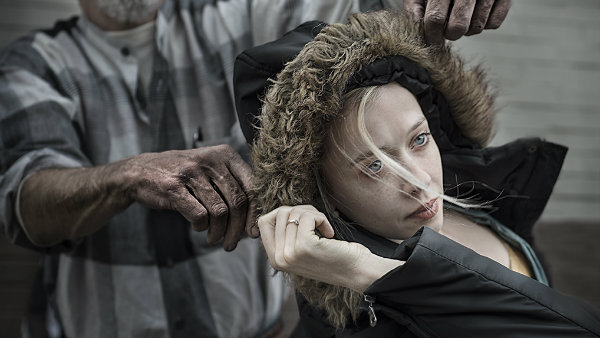

Since moving to its new location in Five Points last year, the dance company has attracted the attention of many people in the neighborhood, including homeless individuals.
After hearing about various exchanges between Wonderbound’s dancers and the homeless community, Lena Prieto wanted to explore the relationship with her photography.
A native of Spain, Prieto studied sociology at the University of Barcelona. After the country’s financial crisis erupted in 2008, she left her public administration job within the Council of Catalonia in 2010 to travel. While visiting places like New Zealand, Australia, Costa Rica and San Francisco, she developed her interest in photography.
“I came back home and I realized I have it finally: that passion that some people are searching for their whole lives,” Prieto says.
Now she combines her academic background with her interest in photography as she treks across the world to document a variety of issues.
For example, Prieto has examined the topic of sexual health while documenting relationships between young people in Lebanon’s Palestinian refugee camps.
The photographer landed in Colorado in spring 2013. Her curiosity led her to Denver, where she found the Salvation Army’s Crossroads Shelter and began photographing homeless subjects.
“I have always been interested in the people who have no roots, who have no house, no home,” Prieto says. “Probably I try to understand myself through others, through the subjects like homeless people and refugees.”
While visiting Five Points in Denver, she also witnessed the activity among neighborhood homeless, artists at the RedLine Gallery and the staff at Wonderbound, whose next show “Love” opens February 14.
On Wednesday, Jan. 29, Prieto captured interactions between the dancers and homeless individuals, and she is now organizing a show at RedLine with the help of photographer Mark Sink.
View the photographs that were provided exclusively to Colorado Public Radio in the audio slideshow below, and also read a Q&A with Prieto to find out more about the project.
CPR: What is your impression of Denver?
Lena Prieto: The first impression that I had was great and pretty scary, but it’s because of the unknown. I arrived on St. Patrick’s Day weekend in March, and people were so drunk.
But it has a lot of energy and a lot of young people, that’s pretty cool. It’s a very dynamic city. I like the western edge of Five Points a lot, it has some design studios and really nice graffiti. So I started to ask: Wow, what’s going on here? It’s not just homelessness that I see, there’s contemporary dance and studios with programs for homeless people who feel they need to express via art. And I think that’s great.
CPR: How did you discover Wonderbound?
Lena Prieto: I think that everything came to me just walking down the street following a guy, asking where he’s going. Entering the shelter with him and discovering a new world behind those walls that no one cares about so much or tries to avoid. And then I was doing the same around here. I went out from the St. Francis Shelter and then saw the RedLine Gallery and they have the Reach Studio. They are interested in what’s going on because they are part of this shared space. Going around I crossed Wonderbound, and I entered because I have been doing dance for five years, so I felt so attracted by that. I was taking photos and then I realized: Why not mix it? Everything came to me just being curious and not afraid to cross the door.
CPR: Why is homelessness an important issue for you?
Lena Prieto: People walk down the street and they look at homeless and sometimes they are afraid and feel uncomfortable, so I’m trying to break those kinds of feelings and just go directly in without any fear. Because that’s what happens when you don’t know who is your neighbor. But then you cross some walls and you say “Hi” every morning, and it’s pretty cool.
Which kind of society do we want to be, that one that leaves people living on the street in those conditions or that one that wants to take care of the people and give them dignity and another chance? Because it’s much easier to end up out there than it seems.
In Barcelona, it’s different. There are no shelters like here where people just stop, sleep and go. Instead they have programs and people have to have responsibilities, like education, so they can come back into the system. Here it’s an emergency moment, you cannot die on the street so we offer a roof. In Barcelona, they don’t agree with that model, they say that it needs to be something else behind. They try to go to the causes. I agree, but the situation also is not as bad as here.
CPR: How did you pick the subjects specifically for this shoot?
Lena Prieto: Ricky Kohrumel for example, I remember meeting him in the Crossroads Shelter. Every one has different objects on the bed or in small place they have. He had a photo of a dancer, and I thought he is sensitive to art or at least to dance. So I asked him. I have other people who I know they are pretty interested in art in general or they are writers.
It’s become an experiment. Just putting two groups together to improvise and see how they react. I think that the sociologic background affects me because I am trying to mix different groups that are sharing the spaces because of the sense of social cohesion that I’m looking for somehow. You know it’s pretty cool to see dancers having a break, smoking cigarettes with homeless people. I think that’s a good result of what I’m trying to do. And I believe in real change, I believe in impact. That’s why I’m in direct contact with the people.
CPR: How did you feel about the photography shoot and what do you think now after the fact?
Lena Prieto: At the beginning I felt so nervous. I thought it was going to be a disaster. It was a lot of tension and expecting that I do something. I knew that they would be looking at me and saying, “Now what?” Now just let it go, let it flow. The beginning was quite awkward, then it was funnier, then it was awkward again. Then it was more natural, then finally it was inspirational. I saw some feelings flowing and some truth and some hugs and some laughs. So I think it was really successful.









